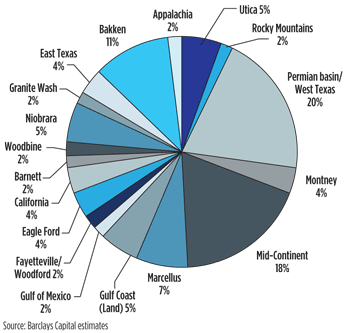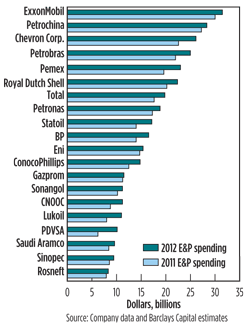JAMES C. WEST, ANTHONY WALKER, ZACHARY SADOW AND RACHEL NABATOAN, BARCLAYS CAPITAL
Global E&P spending in 2012 will approach $600 billion, vs. $544 billion in 2011, according to the Barclays Global 2012 E&P Spending Outlook. The acceleration in worldwide spending is expected to be led by increased expenditures internationally (up 11%), in addition to solid growth in North America (up 8% year-over-year). By region, E&P spending is expected to rise most meaningfully in Latin America, Africa, Europe, the Middle East and Russia. The forecast is based on responses from 351 oil and gas operating companies, including integrated oil companies (IOCs), independents and national oil companies (NOCs).
North American exploration and production spending is slated to increase 8% in 2012 to $160 billion, led by spending gains in the United States. Exploration and production expenditures in the U.S. are projected to rise 10% to $122 billion, while Canadian spending should grow 3% to $37 billion. We expect the push into oil and liquids-rich plays to continue. Despite an expected decline in the natural gas rig count during 2012, the U.S. land market is likely to remain resilient with oil-directed drilling mostly offsetting this weakness.
In Canada, survey results are likely understated and reflect oil-price forecasts significantly below current levels. The Canadian market will remain solid, and actual spending is likely to be roughly in-line with U.S. levels.
In aggregate, oil and gas companies are basing 2012 capital spending budgets on an average oil price of $87 WTI (West Texas Intermediate) and $98 Brent Blend. This compares to current WTI and Brent prices of $101 and $110, indicating that oil and gas companies are likely taking a conservative view on oil prices, given the uncertain economic environment. However, a majority of the surveyed companies (60%) would increase spending if WTI averaged above $100/bbl, which suggests that there is considerable upside to our current forecast for 2012 spending.
Spending by the supermajors in 2012 is expected to increase globally by 12%, led by active drilling and exploration programs for BP, ConocoPhillips, Total, Chevron and Shell (all up by greater than 10%). Spending by ExxonMobil is also projected to rise, although by a more modest 5%. The supermajors are increasing spending in North America by 25% and internationally by 10%.
| Worldwide E&P capital spending by company type/region, 2011–12 |
 |
LESS VOLATILE SWINGS
We continue to believe the oil and gas industry is in the early stages of a multi-year, double-digit growth spending upcycle internationally, characterized by increased drilling in complex geologies on land, and exploration and development of traditional and emerging deepwater basins. Although North America has historically been a short-cycle market characterized by volatile swings in activity, the shift towards oil-directed and liquids -rich activity is reducing the cyclicality of the region and will result in more consistent and growing spending levels. Spending growth in North America should remain in the high single digits through 2015.
U.S. upstream capital spending budgets should rise 10% to $122 billion. North America has historically been a gas-directed drilling market. This year, the oil rig count overtook the natural gas rig count for the first time since the end of 1993. The overall gas share has dropped across-the-board, with the most dramatic shifts occurring in the Gulf Coast and the Mid-Continent. The North American market will be less cyclical going forward, given an increased exposure to oil and liquids-rich drilling. During 2011, company respondents spent 62% of their budget on shale plays while 64% allocated spending for shale plays in 2012. The majority of companies plan to increase spending in the Permian basin/West Texas (20%), primarily an oil basin. Other areas that should have increased spending are the Mid-Continent (18%), the Bakken (11%) and the Marcellus (7%).
The Gulf of Mexico recovery has taken hold. There are now 23 floaters working in the Gulf, up from four in August 2010 and more than 30 prior to the moratorium. Recent discoveries by ExxonMobil, Shell and Anadarko, and delayed drilling programs, have led to a sense of urgency fueling the recovery. There is a shortage of deepwater rigs that meet heightened safety expectations for near-term projects. As a result, dayrates have recovered to over $500k, up from around $400k following the moratorium.
Canadian E&P spending in 2011 is expected to grow 3% to $37 billion. The results of our survey are likely understated and reflect oil-price forecasts significantly below current levels. Many Canadian budgets appear to have been set during the late October/early November timeframe, when oil prices were in the mid-$80 range. We expect the Canadian market to remain solid and actual spending levels are likely to be roughly in-line with U.S. levels.
STIMULATION MARKET UNDERSUPPLIED
Oil service equipment capacity in North America will remain tight through 2012, including the fracturing/stimulation market. We believe both the U.S. and Canadian stimulation markets remain currently undersupplied (by up to 20%). Despite a significant amount of capacity expected to enter the market throughout the year, activity is likely to continue to outstrip supply. In addition, supplier bottlenecks continue to impact delivery of equipment. Lead times for new pressure pumping units remain in the nine-to-12-month timeframe.
The availability of skilled labor to staff new crews is also likely to limit or slow the deployment of additional equipment, particularly in Canada. However, pricing for pressure pumping services is flattening and may decline in select regions.
| Expected increase/decrease in 2011 exploration and production expenditures (2011E vs 2010A) |
 |
 |
| U.S. regions with the greatest increase in spending in 2012 |
|
LATIN AMERICA TO LEAD INTERNATIONAL SPENDING
For the second consecutive year, global E&P expenditures should rise by double digits. E&P spending outside North America will be up 10% this year, to $598 billion.
The top 20 E&P spenders globally account for nearly 57% of total spending. Of these, all 20 are expected to increase capex during 2012 (by an average 13%). ExxonMobil remains the largest capital spender in the world; however, Petrochina is gaining ground. According to its multi-year plan, Petrobras could also close the gap in the next several years and Chevron is also aggressively increasing its spending.
Supermajors. We believe continued high spending levels for the supermajors is being driven by years of flat spending and underinvestment in the early to mid 2000s, resource nationalization which has resulted in the expansion of deepwater drilling activity (particularly in Brazil and West Africa) and the need to find and replace large pockets of reserves and increase production.
Active exploratory programs in offshore markets in West Africa and East Africa, and the continued ramp-up in activity levels in Iraq are also contributing to year-over-year growth.
Latin America. Latin American E&P spending is projected to rise by 21% in 2012. Spending gains are expected to be led by significant pickups in activity in Brazil (Petrobras up 13%), Venezuela (PDVSA up 62%), Colombia (Ecopetrol up 25%) and Mexico (a 17% increase slated for Pemex). In Mexico, spending increased dramatically in the second half of 2011, and this trend is likely to continue next year, as the country battles increasing decline rates at major oil fields. Spending in Brazil is also expected to trend higher.
Middle East and Africa. E&P expenditures in Africa are expected to increase by 14% in 2012 to $30 billion from $26 billion in 2011. This follows a disappointing 2011, where political instability in several countries, government overhauls and administrative issues resulted in significantly curtailed spending. We expect a significant amount of next year’s projected gains to come from emerging developments in areas such as East Africa.
Spending in the Middle East will increase 12% next year, led by a pickup in activity in Iraq, Saudi Arabia and Kuwait. Iraq is one of the largest market opportunities for oil service and drilling companies this decade. The market in Iraq is around $1.5 billion and may grow to $6-8 billion over the next several years.
Asia–Pacific. Spending for select companies in India, Asia and Australia should increase 7% in 2012, led by a ramp-up in expenditures by CNOOC, Petronas and Inpex Corp. Asian companies are investing heavily in international joint ventures, particularly in deepwater projects. CNOOC continues with major development plans in Bohai Bay, and is also increasing activity in Indonesia. Woodside is skewing numbers down next year as the company finishes up its Pluto project.
Europe and Russia. Spending for select European E&P companies should increase 13% in 2012. This is likely to be driven by increased exploration activity in the Norwegian portion of the North Sea, while UK tax reform could negatively impact activity in 2012. During 2011, both Statoil and Lundin Petroleum announced major offshore finds in Norway, both of which are among the 10 largest discoveries in history. This has resulted in renewed optimism regarding the productive potential of the often termed “Dead Sea”.
Spending for select companies in Russia is expected to grow by 12% in 2012, led by a significant increase in E&P activity by Lukoil. The Russian major announced that between 2012 and 2014, it plans to invest $48 billion to increase productive capacity, including close to $14 billion in 2012.
International spending by North America-based firms. Although spending by North American independents internationally is expected to increase again in 2012 (up 3% from 2011), the majority of companies appear to be shifting E&P expenditures to the U.S., given the ongoing oil renaissance and improving outlook in the Gulf of Mexico. However, there are several exceptions, including Canadian Natural Resources (international spending up 59% in 2012), Murphy Oil (up 52%), Noble Energy (up 36%), Nexen (up 26%) and Anadarko (up 13%).
Those North American companies expected to significantly decrease expenditures in the international markets include ATP Oil and Gas (down 60%), EOG Resources (down 25%), Occidental Petroleum (down 23%) and Apache (down 16%).
 |
| Top 20 global spenders ($ in billions) |
|
FINDINGS OF INTEREST
We asked the companies in our survey a number of questions about their budgets. The results of these questions follow:
-
Most companies surveyed (62%) expect to spend within their cash flow during 2012, with 37% projecting expenditures to be equal to cash flow and 25% expecting spending to be less than cash flow. The percentage of companies expecting to live within cash flow is flat vs. 2011, which included 18% of companies spending less than cash flow and 44% equalling cash flow.
-
Recent exploration success in various regions of the world confirms our view that exploration is likely to be at the forefront of spending growth in 2012. In 2010, 32% of respondents planned on increasing the percentage of the budget dedicated to exploration. This percentage grew to 38% in 2011 and 42% in 2012.
-
In a departure from recent years, our survey indicated that the most important determinant of E&P spending in the coming year is oil prices (54%), followed closely by natural gas prices (47%) and cash flow (46%). We believe the shift in key determinants to oil prices is linked, in part, to the change in the North American market.
-
The overall increase in global E&P expenditures in 2011 is estimated to be above the growth forecast in our mid-year 2011 report. This is primarily due to the fact that many companies overspent both their initial budgets and budgets that were revised higher during the year (38% overspent globally).
-
Roughly 27% of companies surveyed plan on increasing spending if natural gas prices average $4.50/MMbtu in 2012, and 70% would do so if they average $5.00/MMbtu. Nearly half of surveyed companies would cut back spending if gas averaged $3.50/MMbtu, while $3.00/MMbtu was the most popular threshold for companies to reduce budgets. 
EDITOR’S NOTE: It is not statistically accurate to compare total estimates with those from prior years because the companies surveyed vary from year to year.
|






